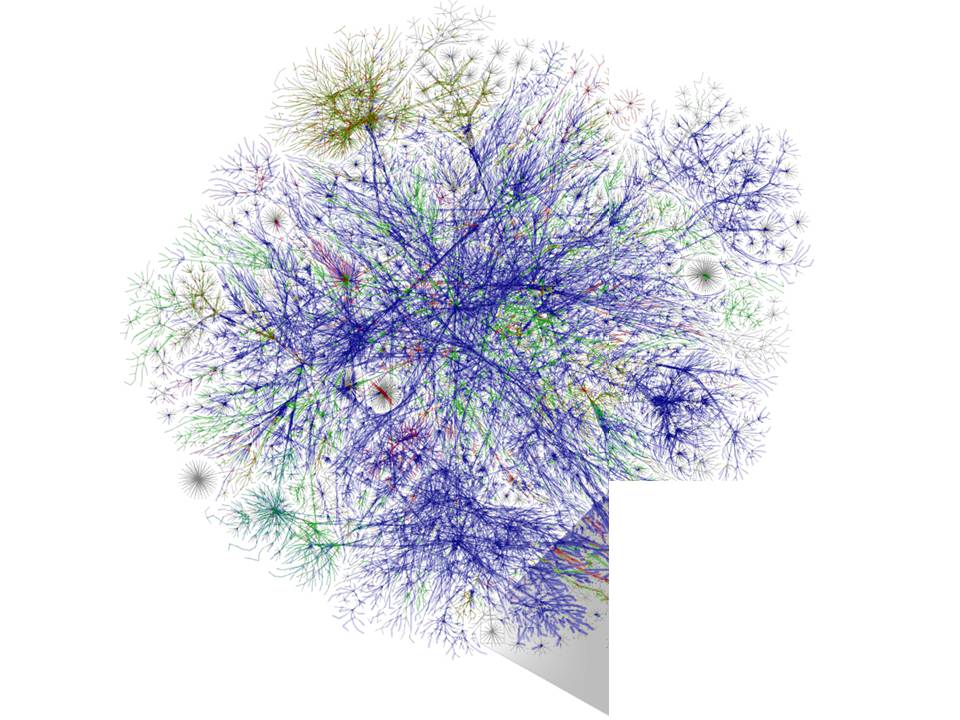Recently I’ve been reading about network theory, an inter-disciplinary study related to complexity theory and systems theory. I’m very much struck both by how much it supports the approaches in Middle Way Philosophy, and by how it could help the presentation of it. Network theory studies the properties of any network: for example, the network of connections on the internet, the social connections between friends and relatives (online or offline), the connections between animals, plants, and non-organic elements in an ecosystem, or the neural connections in the brain. The illustration is of network connections on the internet, but it could conceivably be a diagram of any of a number of other types of complex network.

What makes a network complex (and thus not entirely predictable) is the potential for any element in it to connect to any other element. If you are connected to a computer (or smartphone) reading this now, you are part of a network that could potentially connect to many millions of other machines. If the network is your brain, then it is even more complex than the internet: there are an estimated 100 to 500 trillion neural connections in an adult human brain.
We’re more in the habit of thinking of social or ecological networks than of ourselves as networks, but if we can do so it could open up our thinking in many useful ways. We need to think of ourselves as a network of neural connections that is so mind-bogglingly complex that it can create consciousness, ego, experience, and all those other features we think of as ours. That model can make it easier to explain both how desire, meaning and belief relate to each other (all of them consist in neural connections or disconnections), and how our desires, meanings and beliefs can be more or less integrated – depending on how well interconnected the different parts of the network are. Of course, this is a simplification of the actual processes in the brain, but a model that might be helpful.
Network theory talks in terms of strong ties and weak ties between nodes on the network. In the picture, strong ties are the thicker lines, thinner the weaker ties. Strong ties, either in an individual brain or in a society, would correlate to strongly shared beliefs which are based on well-worn cognitive models. Weak ties, on the other hand, provide further potential beyond those well-worn channels, and might be associated with creative thinking and new metaphors. Two or more clusters of strong ties that are only weakly related to each other suggest unintegrated and possibly polarised beliefs. It is very difficult to say how far such patterns could actually be traced in a brain, where there would also be many other processes occurring, but I presume that this is what we would be able to see if we could isolate the pattern of neural connections that were most relevant to the beliefs concerned.
I think that the Middle Way might well be conceived as involving a balance between strong and weak ties in relation to our meanings and beliefs. We can have strong beliefs in the sense of lots of strong ties integrated into a single pattern, without neglecting weak ties. However, those with strong beliefs often unfortunately maintain them by trying to impose an exclusivity on the network that it cannot have. Imagine a part of a network with a strong central node and very strong links to other nearby nodes – but hardly any links beyond that. At a social level that would be the pattern of an exclusive cult, or an isolated authoritarian institution, and it would also be the pattern that members of such groups would try to impose on their brains. This kind of exclusive pseudo-network of strong ties would represent metaphysical belief. Of course, those who try to impose such a pattern on their brains do not completely succeed, because they continue to be embodied beings requiring all sorts of other neural links, but the dominance of left hemisphere function can still make such imposed patterns dominant in conscious experience, and do quite enough damage.
Alternatively one could potentially have lots of weak ties, and be very open to a variety of experiences and ways of thinking, but lack the core of strong ties that are necessary to be effective in practice. We can’t avoid having beliefs if we want to do anything, and when we act, the clearer and more comprehensive those beliefs are, the better. Lots of strong ties mean power, whether that the political power of a person in a social network or a belief in a neural one, because the more nodes that can be united by similar motives, the stronger the capacity to act.
Network theory also talks about equilibrium in a network. This is when the different elements in the network have no incentive to radically change the network. This state of equilibrium (also known as homeostasis) will occur when the network addresses the conditions it needs to address. This is perhaps easiest to see in an ecosystem, where different creatures can settle into a ‘balance’ despite the fact that they are probably eating each other. My suggestion would be that our best chance of addressing the complex and changing conditions around us in a sustainable way, and thus developing this equilibrium, is to maintain a balance of strong and weak links. That way we can both act effectively in the current situation and think flexibly when new conditions arise.
Picture: Internet connections by the Opte Project (Wikimedia Commons)
